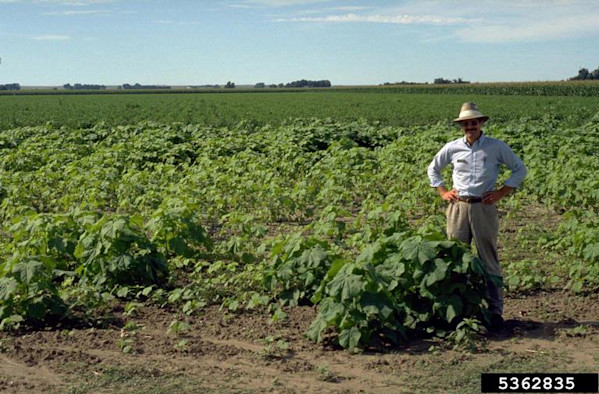How to Identify Velvetleaf
Identifying velvetleaf early is crucial for effective management. Here are a few characteristics to help farmers recognize this invasive weed:
Seedlings:
The first leaves are heart-shaped, with a smooth surface and a slightly notched tip. They are typically about 1-2 cm long.
The stem below the first emerging leaves is often covered with fine hairs.
Leaves:
Shape: Velvetleaf leaves are large, heart-shaped, and can grow up to 6-8 inches long and wide.
Texture: The leaves have a velvety texture due to a dense covering of fine hairs.
Color: They are typically a bright green color.
Arrangement: Leaves are arranged alternately along the stem.The leaf stalk (petiole) is long and also covered with fine hairs.
Stems:
Height: Velvetleaf can grow up to 8 feet tall.
Texture: The stems are stout, erect, and covered with fine hairs, giving them a velvety feel.
Color: Stems are green but may have a reddish tinge.
Flowers:
Appearance: The flowers are small, about 1 inch in diameter, with five yellow to orange petals.
Bloom Time: Flowers typically bloom from mid-summer to early fall.
Location: Flowers are borne singly or in small clusters in the leaf axils (where the leaf meets the stem).
Seed Pods:
Shape: The seed pods are distinctive, resembling a small, spiny, cup-like structure with a series of beak-like projections.
Size: Each pod is about 1 inch in diameter.
Color: Pods are green when immature and turn brown as they mature.
Seeds: Each pod contains numerous small, hard, kidney-shaped seeds that are dark brown to black.
Roots:
Type: Velvetleaf has a taproot system.
Depth: The taproot can penetrate deeply into the soil, making mature plants difficult to pull out.
By closely examining these characteristics, farmers can accurately identify velvetleaf and implement appropriate control measures to manage its spread and impact on crops.
Photo Credit: Phil Westra, Colorado State University, Bugwood.org


